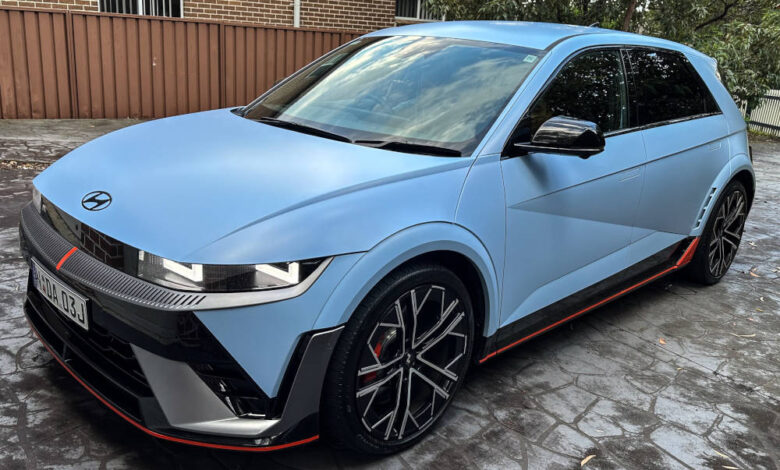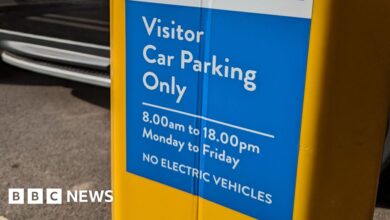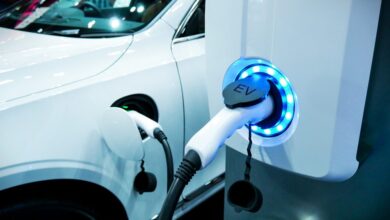Is this the best fully electric performance car?

The Ioniq 5 N is Hyundai N’s first performance electric vehicle and it has already received numerous accolades such as Top Gear’s 2023 Car of the Year Award and 2024 World Performance Car of the Year. It also holds the electric SUV lap record for Germany’s famously gruelling Nürburgring Nordschleife racetrack.
Hyundai opened pre-orders for Ioniq 5 N in October 2023 with Australian pricing and details officially revealed in February 2024. Hyundai does not appear to have any issues with limited supply like the initial Ioniq 5 launch, with most Ioniq 5 N configurations showing available for immediate delivery on the Hyundai website.
Closest electric performance rivals for the Ioniq 5 N include Kia’s EV6 GT sibling, Ford Mustang Mach-E GT and Tesla Model Y Performance. Expanding the scope beyond SUVs adds the new Tesla Model 3 Performance, BYD Seal Performance and Polestar 2 Long range Dual motor with Performance pack.
The Porsche Taycan sets the benchmark for electric performance vehicles currently available in Australia, although it comes with a hefty price premium. For example, an all-wheel drive Taycan Turbo 4S starts from over $200,000 and completes the 0-100 km/h sprint 0.3 seconds slower than the Ioniq 5 N.
Ioniq 5 N pricing starts from $111,000 plus on-road costs, with only two optional extras available. Premium matte paint is $1,000 and a fixed panoramic glass vision roof is available for $2,000. NSW driveaway pricing for the vehicle tested here in Performance Blue Matte paint without the glass roof is $120,208.
At this price, the Hyundai Ioniq 5 N is more expensive than all of its closest competitors except the Taycan. However, it offers endless amounts of customisation for drivers and promises serious performance credentials with years of development by Hyundai’s N sub-brand engineers.
Ioniq 5 N hardware changes
Hyundai N vehicles are designed with three pillars in mind – racetrack capability, corner rascal and everyday sports car. The Ioniq 5 N features numerous upgrades over a regular Ioniq 5 to ensure each of these pillars has been satisfied, making this a true Hyundai performance N car.
Exterior changes for the Ioniq 5 N include new front and rear bumpers with aero guides, an extra front air intake for cooling, wing-type spoiler and body kit. These upgrades provide additional cooling capacity and aerodynamic performance as well as styling to make the car look more aggressive.
Wheels are upgraded to a forged aluminium design 21 inches in diameter, fitted with 275 mm wide Pirelli P Zero tyres all around. Upgraded brakes feature four-piston monobloc callipers with 400 mm discs up front and 360 mm at the rear.
Overall, these exterior changes to the Ioniq 5 N make it 50 mm wider and 20 mm lower than a regular Ioniq 5. Despite being wider, the styling changes somehow seem to make the Ioniq 5 N appear smaller and less boxy. It is even better looking than the original in my opinion, not that regular Ioniq 5 is bad looking at all.
Interior upgrades include N bucket seats, N steering wheel, track-optimised centre console sport pedals and footrest. The bucket seats are manually adjustable, but still feature heating and ventilation. Drive mode, N Grin Boost and two customisable N buttons on the steering wheel provide easy access to adjust vehicle settings without having to use the touchscreen.
The most important upgrades are those you can’t see, such as more powerful electric motors capable of spinning up to 21,000 RPM, electronic limited slip differential (e-LSD) on the rear axle, electronic controlled suspension, stiffened body, reinforced chassis and steering column.
Ten unique N modes
To address the three Hyundai N pillars, the vehicle hardware changes described above are complemented by ten unique N drive modes and features to increase driver engagement and make the car more fun to drive. These modes along with a brief description from Hyundai are below:
- N Active Sound + (NAS+) – High performance sounds delivered via internal and external speakers.
- N Battery Preconditioning (NBP) – Pre-conditioning for optimal battery temperature for Drag and Track driving.
- N Drift Optimiser – Circuit feature delivering optimised torque distribution to enable pro-driver style drifting.
- N e-Shift – Virtual shift control for intuitive feel based driving.
- N Grin Boost (NGB) – Maximum power delivery for 10 seconds.
- N Launch Control – Acceleration assist with user configurable road grip level for optimised torque control.
- N Pedal – Circuit feature to enable 1 pedal driving for pro-driver style weight transfer and turn in.
- N Race – Maximised battery cooling and power control for track driving with Sprint and Endurance modes.
- N Road Sense – Curve sign detection for user prompts to enable N mode.
- N Torque Distribution (NTD) – User configurable driving force distribution allowing up to 100% power delivery to front or rear axle.
Some of these modes are designed for track use only, such as N Race and N Drift Optimiser, so unfortunately I did not get to try them out. Two features I heard a lot about beforehand were N e-Shift which simulates an 8-speed dual-clutch transmission along with N Active Sound +.
Similar to others, I was initially sceptical of how the fake gearbox would feel and could not understand why you would want to hamper an EV like this. However, Hyundai has put so much effort into these features that the effect is very convincing and it made me smile every time I used them.
Enabling N e-Shift starts off in automatic where the car shifts gears, but you can take manual control by simply shifting up or down using the steering wheel paddles. Under hard acceleration you feel a thump in the back when changing up, when torque momentarily ceases and then jolts the car forwards as the next gear engages.
Torque curves for an ICE engine have been accurately simulated too, so if you find yourself in a gear that’s too high, there is limited torque available until you downshift. Speaking of downshifting, the exhaust pops and crackles as you slow down and change gears coming into corners, which made me change down into first gear to hear the effect more often.
The only aspect of an ICE car Hyundai hasn’t simulated is the vibration you would normally feel from an engine, but I think that would be taking things too far. Opinions from family and friends experiencing these features ranged from loving it to being relieved when it was turned off, so your mileage may vary depending on the audience.
If you want to learn more about the rest of these N drive modes, one of my favourite Youtubers, Jason from Engineering Explained recently posted a video going through each of them in detail.
Storage space and interior features
Boot space in the Ioniq 5 N is the same as other Ioniq 5 variants, measuring 480 L with the rear seats up or 1,540 L with seats folded. The underfloor area is big enough to store included charging cables and the tyre repair kit. There is also a handy net that attaches to tie down points for preventing loose items from sliding around.
One notable difference in terms of storage space is the lack of a front trunk (frunk), as one of the two external speakers takes up this space. The area under the bonnet surrounding this is open with easy access to fluid reservoirs, fuse box, 12 V battery and other components you might want to check or change during track sessions.
I found the manually adjusted bucket seats in the Ioniq 5 N were very comfortable on long drives and the additional support keeps you firmly in place while cornering. The rear seats can be reclined and also slide back or forwards to optimise boot space or passenger comfort.
With the rear seats slid all the way back, there is tons of legroom for rear passengers. Amenities in the back include a fold down armrest with cupholders, 2x USB-C outlets, retractable window blinds, air-vents on the B-pillars and decent door pockets although there are no map pockets. A 15 A vehicle to load (V2L) outlet is also located under the rear seat.
Front seat passengers can recharge up to 5 devices at once, as the centre console houses 3x USB-C ports, a wireless charging pad and a 12 V 180 W outlet. Overall the Ioniq 5 N cabin feels well built and premium. If you were nitpicking there are hard plastics used throughout the centre console and door pockets, at least these should be hard wearing.
Infotainment and N mode
The infotainment system in the Hyundai Ioniq 5 N is mostly the same as other Ioniq 5s, featuring the great sounding 8-speaker BOSE premium audio found on Dynamiq and Epiq variants. N mode is unique to the Ioniq 5 N and is where you gain access to N drive modes and customise the vehicle in endless ways.
Jumping into N mode from the home screen panel provides easy adjustment for the track specific features such as N Torque Distribution and N Race. From here you can also enable lap timing by selecting from a list of available circuits and track lengths within that circuit, which is much more sophisticated than lap timers I’ve seen on other vehicles.
Swiping right in N mode allows you to tweak two different N custom modes, where five different aspects of the vehicle dynamics as well as head-up display and artificial sound can be individually adjusted.
N custom modes can then be cycled through using one of the two customisable N buttons on the steering wheel. I configured the second N button to toggle N e-Shift on/off. While in N mode the driver display also changes to show individual motor temperatures, battery temperature as well as a tachometer and gear selection if using N e-Shift.
An information panel on the right hand side can be adjusted to display a g-force graph, tyre pressures, torque from each motor, lap times or trip meters. In summary, the level of customisation and real-time information available to drivers in the Ioniq 5 N is above and beyond anything I have experienced in other electric vehicles.
Versatile driving experience
Under normal everyday conditions, the Ioniq 5 N feels comfortable and easy to drive. When you want to chill out or your passengers aren’t keen on the gearbox and engine sound, you can ignore the special N features and enjoy a smooth quiet ride. The suspension feels firm in normal drive mode but never uncomfortable, and is softer still when using eco.
Drive past a twisty corner sign and N Road Sense invites you to switch on N mode by pressing the OK button or whichever N button you have allocated on the steering wheel. At this point you come to appreciate having all those buttons at your fingertips, so you can keep both hands on the grippy, textured leather steering wheel.
Suspension and handling in the Ioniq 5 N is superb, better than anything I have ever driven and another step up from the Kia EV6 GT I tested recently. It felt like the car barely broke a sweat no matter what I threw at it, carving corners with confidence. You need to drive this car on a racetrack to appreciate what it is truly capable of.
Power coming from the upgraded electric motors and battery pack is enough to propel the 2,230 kg Ioniq 5 N from 0-100 km/h in 3.5 seconds or 3.4 with N Grin Boost. Using the built-in acceleration timer, I fell just short of these times although the road surface I tested on was not ideal.
Regenerative braking is adjustable via the steering wheel paddles with five different levels from off to i-Pedal or one pedal driving. I found it suitably strong and well tuned like other Hyundai EVs. I was pleasantly surprised to find the i-Pedal can now be enabled while in park, but it still turns off in between drives and after reversing.
Driver assistance systems worked well in the Ioniq 5 N, apart from the speed limit warning which often gave false positives after detecting the wrong limit. Adaptive cruise control and lane centering adjusted speed appropriately and kept the car positioned accurately. Lane change assist is also available on multi-lane roads and also worked well for me.
The Ioniq 5 N includes a digital rear-view mirror which uses a camera mounted just below the rear spoiler. I found the camera quality was decent but suffers from glare at night time with headlights behind you. It also takes some mental adjustment to refocus your eyes from distance to close up.
Rear visibility was good enough without the camera, so I’m not sure what the use case for the digital mirror is. Either way, the digital rear-view mirror is one of the features coming in refreshed Ioniq 5 vehicles later this year along with the larger 84 kWh battery pack found in the Ioniq 5 N.
Efficiency figures during my testing showed average consumption of 20.8 kWh/100 km for city driving. Earlier in the week while showing off the car and its features the figure rose to 21.9 kWh/100 km. On a highway loop I consumed 21.0 kWh/100 km. All of the performance and features available in the Ioniq 5 N mean it is not the most efficient car.
Charging and ownership
Charging specifications in the Ioniq 5 N are identical to other long range Ioniq 5s. Highlights include 18 minute charge time from 10-80 % using a 350 kW charger and vehicle to load (V2L) capable of providing up to 3.6 kW, either through the internal 15 A outlet or the optional V2L connector for $595.
Warranty and servicing are also identical to other Ioniq 5s, with a 5 year unlimited km vehicle warranty and 8 years or 160,000 km battery warranty. Service intervals are every 2 years or 30,000 km and pre-paid plans cost $625 each for the first three services.
EV trip planning and locating charging stations through the built-in navigation system works well, finding lots of nearby options when I tried out this feature. Over-the-air (OTA) updates are also included as well as wireless Apple CarPlay and Android Auto.
Tyres are going to be the biggest ongoing expense for Ioniq 5 N owners. A set of four factory fitted Pirelli P Zero 275/35 ZR21 103Y tyres costs between $2,500 – $2,900 according to a search online.
Conclusion
How does the Ioniq 5 N stack up against the three Hyundai N pillars – racetrack capability, corner rascal and everyday sports car? Unfortunately I did not get to drive the Ioniq 5 N on the racetrack, so I will defer to fellow contributor Bryce Gaton’s earlier review from Hyundai’s media launch event to help answer that part.
After spending a week with the car I feel Hyundai has nailed the other two N pillars, delivering an impressive performance car, electric or otherwise. The Ioniq 5 N is extremely versatile, comfortable and functional as an everyday car while being capable of instantly transforming into a sports car with the press of a steering wheel button.
The Ioniq 5 N does need a racetrack to utilise all of the performance and unique N drive modes, but is still worthwhile if you are looking for something fun to drive and full of customisable features.
Given how impressive Hyundai’s first electric N car is, I am excited to see what their future models have in store. Hyundai have given us some hints of what is possible with the RN22e Rolling Lab and NPX1 concept pictured below. Rumours suggest the upcoming Ioniq 6 N will have some extra tricks up its sleeve compared to the Ioniq 5 N.
Table of key specifications for the Hyundai Ioniq 5 N:
| Variant | Hyundai Ioniq 5 N | ||
| Starting price | $111,000, plus on-road costs | ||
| Paint colours and options | 6 colours at no cost:
3 premium colours for $1,000 extra:
Vision panoramic glass roof – $2,000 |
||
| Battery size | 84 kWh gross, 80 kWh usable | ||
| Battery chemistry and manufacturer | Nickel Manganese Cobalt (NMC), SK Innovation | ||
| Range | 448 km WLTP | ||
| Driven wheels | All-wheel drive | ||
| Power / Torque | 448 (478) kW / 740 (770) Nm (with N Grin Boost) | ||
| Charging socket | CCS2 combo | ||
| Maximum charging speed | 233 kW DC, 10.5 kW AC | ||
| Charging time | 7 kW AC (10 – 100 %) – 10 hours 50 minute 50 kW DC (10 – 80 %) – 70 minutes 350 kW DC (10 – 80 %) – 18 minutes |
||
| Exterior dimensions | Length: 4,715 mm Width: 1,940 mm Height: 1,585 mm Wheelbase: 3,000 mm Ground clearance: 142 mm |
||
| Kerb weight | 2,230 kg | ||
| Storage space | Frunk: N/A Boot, rear seats up: 480 L Boot rear seats folded: 1,540 L |
||
| Service interval | 24 months / 30,000 km | ||
Tim has 20 years experience in the IT industry including 14 years as a network engineer and site reliability engineer at Google Australia. He is an EV and renewable energy enthusiast who is most passionate about helping people understand and adopt these technologies.



